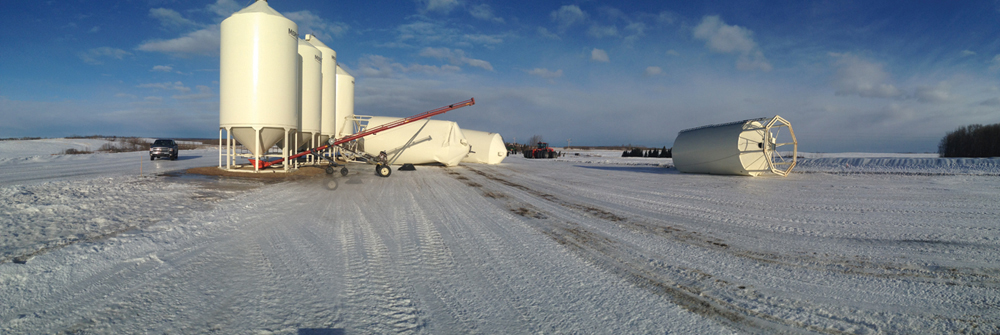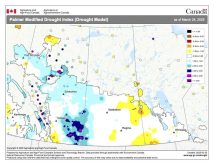It doesn’t matter what side of the climate change debate you’re on, few producers would deny that, for whatever reason, weather is getting more extreme.
Between hurricane-force winds and the generally lighter and taller designs of many modern grain bins, there seems to be more instances of grain bins being knocked over or otherwise damaged.
That means proper anchoring has become more important than ever.
“It seems like we’re getting more and more of these kinds of storms all the time,” said Rob Reimer, Canadian sales manager with Meridian Manufacturing. “The anchoring of bins is definitely happening more now than it was years ago. I always say it doesn’t matter how long you have the bin empty, if it’s going to be empty for any amount of time the best thing is to anchor it and secure it properly.”
Read Also

Thunderstorms and straight-line winds
Weather columnist Daniel Bezte discusses the strength of straight-line winds during a thunderstorm and the damage they can cause.
While anchoring doesn’t guarantee an empty bin won’t blow over, it reduces the odds, shows due diligence if there’s an insurance claim, and, best of all, it’s cheap.
“With anchor screws you’re looking at $20 to $25 each so if you put four of them into the ground you’re looking at $100 max,” said Reimer.
Ryan Steinley with Flaman Agriculture in Lethbridge agrees.
“The largest flat bottom I’ve seen blow over was probably a 20,000 bushel,” he said. “The biggest hopper bottom bin I’ve seen blow over is probably about a 10,000 bushel in 110-mile-an-hour wind.
“Basically the bigger anchor you can use and the farther down you can get it in the better. The more anchors you can use the better. For hopper bottom bins, anchor every hopper leg.”
Concrete best bet
Anchoring a bin is done one of two ways: either by installing on a concrete pad or by using a steel skid anchor. Concrete is preferable whenever possible, said Reimer, and best secured by anchor bolts drilled into the concrete pad, usually with a hammer gun.
“Your bin really won’t go anywhere on concrete,” said Reimer. “If the plow winds are strong enough, you can get some damage on the sidewall of the bin. But those anchors on the concrete will not give in.
“On a skid base on gravel you are still susceptible to heavy rains or moisture conditions where the ground shifts and then the bin shifts — you don’t get that on concrete.”
A concrete base also helps keep areas beneath and around the bin clean.
“When you have the leg structure on concrete, it’s easy to clean if you get anything underneath the bin,” said Reimer.
All about the base
Steel skid anchors, which are essentially a series of screws installed in the ground and attached to a bin with cables, are a good option for producers using bins in temporary locations or looking to retain the resale value of their bins.
However, they are only as effective as the strength of the grain bin base and its depth into the ground, said Reimer, who encourages producers to use a gravel base or some other kind of solid base.
“We will generally request that they take out the topsoil, get it down to a firm bottom, roughly in the 12-inch range, and then put a solid base on top,” he said. “With any structure, if the base underneath is not solid or if there’s too much give on the bottom the base or the structure of the bin will fail.”
Skid anchor screws are usually four feet long and are equipped with four- to six-inch flighting that prevents them from easily coming out of the ground. They are usually screwed into the ground by hand, although they can also be installed with three-quarter-horsepower air compressors or even fishing augers.
“The four- and the six-inch (flighting) screws are commonly used,” said Steinley. “You can get up to 12 inches (flighting) but hardly any farmer’s got anything to turn that in. The bigger the flighting and the farther into the earth it can go depending on your soil type is the best way to go.”
Although anchoring is key to keeping bins secure, growers should not neglect the importance of bin placement, said Steinley.
If bins are too close together, they can create a solid wall that does not allow the wind to get through, in turn causing damage to bin sidewalls. Placement of six to 10 feet apart is generally recommended.
“You don’t want them too far apart but no closer than two feet apart — a little further would be better,” he said.
















